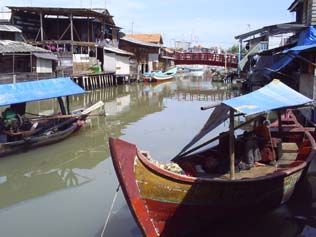Kampung Luar Batang: Jakarta
Jakarta is truly a city of neighborhoods, each with its own physical, social and economic characteristics.
But over the years, as its inhabitants have ventured up river from the coast, it has turned its attention away from its oldest kampong as Anissa S. Febrina writes.
Up until the 1970s, most residents of the 400-year-old Kampung Luar Batang in North Jakarta lived both from and by the sea. Some were seamen, others were fishermen; but none could live without their fishing nets and lines, nor the salty sea air filling their nostrils.
Nowadays, as fuel prices soar and the fish population shrinks, more and more people are giving being a small-time entrepreneur a shot — or seeking the security of employment.
“Being a fisherman or a fish trader is no longer worth the time and energy. The younger generation, myself included, prefer working for someone else or starting up a business,” said Freddy, a 32-year-old native of Luar Batang.
The father of two gave up his inherited profession of pelele or fish trader eight years ago to manage a pool hall owned by a neighbor.
Alleys away from where Freddy makes a living, 57-year old Abdul Manan “retired from a life at sea” when his motorboat sank last November.
“It was a blessing in disguise. I was looking for a way to quit anyway,” the man said as he watched children play the arcade games set up on his verandah.
“This is better, isn’t it? All we do is sit at home — still make money and the children here are happy,” his wife added.
This whole paradigm shift may ultimately have resulted in something positive for the entire kampong of Luar Batang as these small changes have brought a certain liveliness to the area.
But then again, historically, “lively” is Luar Batang’s middle name as it has been a migrants’ hub for centuries. Lying just beside the old Sunda Kelapa harbor, Luar Batang grew from a seamen and fishermen’s settlement.
During the early 17th century, the Dutch, who took over the area from former ruler Fatahillah, required every boat to go through a customs check before entering the port.
While waiting on their entrance permits, the seamen built a temporary settlement outside the border, which was marked by logs that were floated across the mouth of Ciliwung river.
And that was how the area acquired its name, Kampong Luar Batang, which means a settlement outside the log.
Most of the first inhabitants of Luar Batang were seamen and fishermen from South Sulawesi. Later on, in the 1660s, Dutch trading agency Verenigde Oost-indische Compagnie transported fishermen from East Java to the area, noted writer Alwi Shahab wrote in an essay about Luar Batang.
Now, the kampong is no different than many others in the city as more migrants have settled in the 9.5-hectare area. As it became more and more crowded, kampong Luar Batang developed into a lively cluster, hidden behind the fish market.

Its entrance from the market — two wooden bridges — might look like its on its last legs, but its people certainly are not.
“We try to make a living anyway we can,” said Agus Yani, a Luar Batang native of Betawi origin.
Agus buys old bicycles from a trader, renting them to local children for Rp 1,000 an hour.
“The end of year holiday is my peak season. I can earn Rp 50,000 a day,” he said.
Others who are not so creative open grocery stores or food stalls or go into the PlayStation rental business; a few have stayed true to their boats and fishing nets.
Those in Luar Batang have proven that a kampong can withstand the centuries without becoming trapped in past romanticism.
As kitsch as they may look, two-story homes with candy-colored pillars perfectly complement old wooden houses, signaling that while some choose to preserve their old homes, others see the need to keep moving forward. Just as their predecessors did.
It might serve as a turning point for urban conservationists that keeping the spirit of an area alive is just as important as maintaining its physical condition.
Although its infrastructure could do with a few improvements, Luar Batang is already rich in both.
Anissa S. Febrina